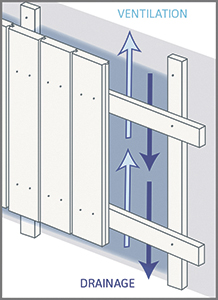Standfirst: A recent flurry of cladding inspection requests received by the Timber Decking and Cladding Association has revealed that basic, fundamental installation principles for timber cladding are being ignored.
Timber cladding is installed as a rainscreen on buildings across the UK. This means the cladding should be fitted over a drained and ventilated cavity, to allow airflow and moisture to escape and give it the longest possible service life.
Ventilation provision is allowed for at the top and bottom of the cladding, while the batten layer or layers – one or two depending on the orientation of the cladding – creates a continuous drainage plane over a waterproof breather membrane.
Unfortunately, several cases where this guidance has not been observed have recently been brought to the Timber Decking and Cladding Association’s (TDCA) attention, and it seems TDCA is not alone.
In a recent newsletter, NHBC reported that it ‘has recent experience with the design life of timber cladding being less than intended, leading to loss of performance and claims.’ It sites ‘lack of detailing to enable drainage and ventilation’ as one of the key problems, as well as the use of ‘unsuitable film-forming coatings that can trap moisture’ and fixings issues. These are all very important factors that builders and tradespeople must get right to prevent future problems.
“Fixings issues have long since been a bug bear of the TDCA in respect to both timber cladding and decking,” explains Janet Sycamore, Director of TDCA. “Most of the cases, we see feature problems caused by using the wrong type of fixing, fixings made of the wrong material, or their incorrect placement and poor application. If you get it wrong the result could be at best permanent, dark, unsightly rust stains or, at worst, boards becoming detached from the wall and potentially causing harm.”
The good news is that these problems are easily avoided by following good practice guidance available from the TDCA and Timber Development UK.
You can find details of this guidance in The Timber Cladding Handbook, which is freely available online at: www.tdca.org.uk
For more detailed information, you can also refer to BS 8605 External Timber Cladding Part 1 – Method of specifying, which is designed to help manufacturers and specifiers.

